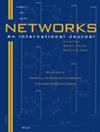多仓库家庭旅行推销员问题和聚类变体:数学公式和基于分支和切割的方法
IF 1.3
4区 计算机科学
Q4 COMPUTER SCIENCE, HARDWARE & ARCHITECTURE
引用次数: 3
摘要
在这篇文章中,我们研究了多仓库家庭旅行推销员问题(MDFTSP)和两个聚类变体,即软聚类MDFTSP(SC‐MDFTISP)和硬聚类MDFTISP。我们强调了这项研究的相关性,将问题与分散存储系统支持的仓库活动联系起来,并指出文献中很少涉及路由问题的集群变体。对于这三个问题,我们提出了几种混合整数线性规划公式,并开发了适当的基于分支和割集的算法,这些算法用新生成的数据集进行了测试,包括具有多达200个节点和40个仓库的实例。计算实验的结果使我们能够确定关于建模方法和求解方法的三个问题之间的主要差异,并证明这些问题是具有挑战性的问题,特别是SC‐MDFTSP。本文章由计算机程序翻译,如有差异,请以英文原文为准。
The multi‐depot family traveling salesman problem and clustered variants: Mathematical formulations and branch‐&‐cut based methods
In this article, we study the multi‐depot family traveling salesman problem (MDFTSP) and two clustered variants, the soft‐clustered MDFTSP (SC‐MDFTSP) and the hard‐clustered MDFTSP. We emphasize the relevance of this study by relating the problems with warehouse activities supported by scattered storage systems and by pointing out that clustered variants of routing problems have been scarcely addressed in the literature. For these three problems, we present several mixed integer linear programming formulations and develop appropriate branch‐&‐cut based algorithms which are tested with a newly generated data set including instances with up to 200 nodes and 40 depots. The results from the computational experiments allow us to identify the main differences between the three problems concerning modeling approaches as well as solution methods and put in evidence that these problems are challenging problems, in particular the SC‐MDFTSP.
求助全文
通过发布文献求助,成功后即可免费获取论文全文。
去求助
来源期刊

Networks
工程技术-计算机:硬件
CiteScore
4.40
自引率
9.50%
发文量
46
审稿时长
12 months
期刊介绍:
Network problems are pervasive in our modern technological society, as witnessed by our reliance on physical networks that provide power, communication, and transportation. As well, a number of processes can be modeled using logical networks, as in the scheduling of interdependent tasks, the dating of archaeological artifacts, or the compilation of subroutines comprising a large computer program. Networks provide a common framework for posing and studying problems that often have wider applicability than their originating context.
The goal of this journal is to provide a central forum for the distribution of timely information about network problems, their design and mathematical analysis, as well as efficient algorithms for carrying out optimization on networks. The nonstandard modeling of diverse processes using networks and network concepts is also of interest. Consequently, the disciplines that are useful in studying networks are varied, including applied mathematics, operations research, computer science, discrete mathematics, and economics.
Networks publishes material on the analytic modeling of problems using networks, the mathematical analysis of network problems, the design of computationally efficient network algorithms, and innovative case studies of successful network applications. We do not typically publish works that fall in the realm of pure graph theory (without significant algorithmic and modeling contributions) or papers that deal with engineering aspects of network design. Since the audience for this journal is then necessarily broad, articles that impact multiple application areas or that creatively use new or existing methodologies are especially appropriate. We seek to publish original, well-written research papers that make a substantive contribution to the knowledge base. In addition, tutorial and survey articles are welcomed. All manuscripts are carefully refereed.
 求助内容:
求助内容: 应助结果提醒方式:
应助结果提醒方式:


